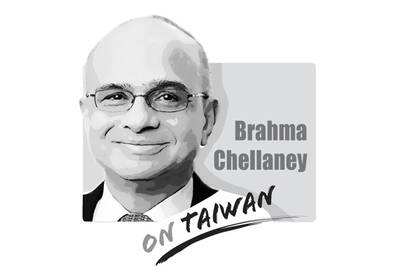Maintaining the “status quo” is a stop-gap measure to address international tensions and maintain stability. There is no win or lose. Maintaining the “status quo” across the Taiwan Strait is eminently preferable to China’s hegemonic expansionism, and Chinese Minister of Foreign Affairs Wang Yi (王毅) is seeking to define the “status quo” with lies, claiming that Beijing is maintaining it.
Wang talks about the “one China principle” and how “Taiwan is a part of China,” and that “despite the long-term political antagonism across the Strait, China’s national sovereignty and territory has never been separated.” This is how he defines the “status quo.”
This is just the latest version of the lie that “Taiwan has been a part of China from time immemorial,” which simply does not comport with the facts.
Hong Kong was ceded to the British, and the British transferred it back, together with documents and a handover.
Taiwan was ceded to Japan through a treaty and handover documents, but after Japan was defeated in World War II, it signed a treaty that only gave up its sovereignty of Taiwan, and from that point it had no authority to hand it over to any country. It certainly did not hand it over to China.
The Manchu’s Qing Dynasty handed over Taiwan to Japan through a treaty, and the person that recorded the process in most detail was former US secretary of state and diplomat John Foster, who was present at the proceedings as US legal counsel. Foster, the grandfather of former US secretary of state John Foster Dulles, published Diplomatic Memoirs in 1909.
Foster had served as legal adviser to Qing official Li Hongzhang (李鴻章) to negotiate the peace terms of the Treaty of Shimonoseki to end the First Sino-Japanese War. Just before Foster departed to return to the US, Li confided in Foster that he and his adopted son, Li Jingfang (李經方), were being accused of having given Taiwan up, which they had not intended to do, and that Li Jingfang had been ordered to go to Taiwan to handle the handover. Li Hongzhang asked Foster to help his son in this ignominious task.
Foster reluctantly agreed, and on May 30, 1895, boarded a ship with Li Jingfang in Shanghai, arriving in Tamsui the next day.
On their arrival, Li Jingfang felt unwell, and there was social unrest in Taiwan, so he requested that they not disembark and conduct the handover onboard instead. The Japanese representative, admiral Kabayama Sukenori, who was also governor-general of Taiwan, agreed.
The two parties finalized the terms on June 2, signing the handover documents that evening, and Li Jingfang and Foster set sail for Xiamen at midnight. They had been moored off the coast for 36 hours.
Wang’s fabrications cannot compete with the facts. Taiwan was ceded to Japan, the procedures had been completed in full, the treaty had been agreed upon and signed and the territory handed over.
After World War II, Japan gave up all rights to Taiwan, but there was no recipient country, nor had there been any handover procedures.
When the Republic of China and the People’s Republic of China (PRC) were founded, neither included Taiwan, and the PRC has never even governed Taiwan.
As a result, the real “status quo” is that neither Taiwan nor the PRC has any territorial claim over the other.
James Wang is a media commentator.
Translated by Paul Cooper

China badly misread Japan. It sought to intimidate Tokyo into silence on Taiwan. Instead, it has achieved the opposite by hardening Japanese resolve. By trying to bludgeon a major power like Japan into accepting its “red lines” — above all on Taiwan — China laid bare the raw coercive logic of compellence now driving its foreign policy toward Asian states. From the Taiwan Strait and the East and South China Seas to the Himalayan frontier, Beijing has increasingly relied on economic warfare, diplomatic intimidation and military pressure to bend neighbors to its will. Confident in its growing power, China appeared to believe
Taiwan-India relations appear to have been put on the back burner this year, including on Taiwan’s side. Geopolitical pressures have compelled both countries to recalibrate their priorities, even as their core security challenges remain unchanged. However, what is striking is the visible decline in the attention India once received from Taiwan. The absence of the annual Diwali celebrations for the Indian community and the lack of a commemoration marking the 30-year anniversary of the representative offices, the India Taipei Association and the Taipei Economic and Cultural Center, speak volumes and raise serious questions about whether Taiwan still has a coherent India
Recent media reports have again warned that traditional Chinese medicine pharmacies are disappearing and might vanish altogether within the next 15 years. Yet viewed through the broader lens of social and economic change, the rise and fall — or transformation — of industries is rarely the result of a single factor, nor is it inherently negative. Taiwan itself offers a clear parallel. Once renowned globally for manufacturing, it is now best known for its high-tech industries. Along the way, some businesses successfully transformed, while others disappeared. These shifts, painful as they might be for those directly affected, have not necessarily harmed society
Legislators of the opposition parties, consisting of the Chinese Nationalist Party (KMT) and the Taiwan People’s Party (TPP), on Friday moved to initiate impeachment proceedings against President William Lai (賴清德). They accused Lai of undermining the nation’s constitutional order and democracy. For anyone who has been paying attention to the actions of the KMT and the TPP in the legislature since they gained a combined majority in February last year, pushing through constitutionally dubious legislation, defunding the Control Yuan and ensuring that the Constitutional Court is unable to operate properly, such an accusation borders the absurd. That they are basing this